Abstract
Bacterial diversity and hydrolytic enzyme activity of paddy soil, paddy soil mixed with cow dung, and paddy soil mixed with cow dung and rice straw samples were studied. A total of twelve different bacterial species were found by 16S rDNA sequence analysis, viz., Bacillus subtilis, Streptomyces colombiensis, Paenibacillus polymyxa, Staphylococcus pasteuri, B. aquimaris, B. licheniformis, B. amyloliquefaciens, Microbacterium testaceum, P. illinoisensis, Micrococcus sp., B. subtilis, Rhizobium tropici, Micrococcus luteus, Bacillacea bacterium, Microbacteriaceae bacterium, B. megaterium. The bacterial strains of the samples were divided into three phyla, namely Firmicutes, Actinobacteria, and Proteobacteria. The population of bacteria under the phylum Firmicutes was highest in all the samples. In addition, the population of bacteria under Firmicutes was gradually increased from the paddy soil sample (60%) to the paddy soil mixed with cow dung and rice straw samples (84%). On the other hand, the population of the bacteria under the phyla Actinobacteria and Proteobacteria gradually decreased from 28 and 12% of paddy soil to 11 and 5% of paddy soil mixed with cow dung and rice straw, respectively. The population of bacteria showing cellulase, xylanase, lichinase, and mannase activity were lowest in normal paddy soil (57, 53, 50 and 18%, respectively), except amylase were lowest in soil samples mixed with cow dung (39%); however, they gradually increased and were highest in the sample of paddy soil mixed with cow dung and rice straw (100, 100, 65, 54, and 61%, respectively). So it was observed that soil samples mixed with cow dung and rice straw may be a good source of plant cell wall degrading bacteria.
Similar content being viewed by others
References
Chandel, A.K., Chandrasekhar, G., Silva, M.B., and da Silva, S.S., The realm of cellulases in biorefinery devel opment, Crit. Rev. Biotechnol., 2012, vol. 32, pp. 187–202.
Cherry, J.R. and Fidantsef, A.L., Directed evolution of industrial enzymes: an update, Curr. Opinion Biotechnol., 2003, vol. 14, pp. 438–443.
Vyas, S. and Lachke, A., Biodeinking of mixed office waste paper by alkaline active cellulases from alkalotolerant Fusarium sp., Enzyme Microb. Technol., 2003, vol. 32, pp. 236–245.
Nannipieri, P., Grego, S., and Ceccanti, B., Ecological significance of the biological activity in soil, in Soil Biochemistry, 1990.
Giri, B., Giang, P.H., Kumari, R., Prasad, R., and Varma, A., Microbial diversity in soils, in Micro-Organisms in Soils, Roles in Genesis and Functions, Buscot, F. and Varma, S., Eds., Heidelberg: Springer, 2005.
Kandeler, E., Tscherko, D., and Spiegel, H., Longterm monitoring of microbial biomass, N mineralization and enzyme activities of a chernozem under different tillage management, Biol. Fertil. Soils, 1999, vol. 28, pp. 343–351.
Lee, Y.J., Kim, B.K., Lee, B.H., Jo, K.I., Lee, N.K., Chung, C.H., Lee, Y.C., and Lee, J.W., Purification and characterization of cellulase produced by Bacillus amyloliquefaciens DL-3 utilizing rice hull, Bioresour. Technol., 2008, vol. 99, pp. 378–386.
Ng, I.S., Li, C.W., Yeh, Y.F., Chen, P.T., Chir, J.L., Ma, C.H., Yu, S.M., Ho, T.H.D., and Tong, C.G., A novel endoglucanase from the thermophilic bacterium Geobacillus sp. 70pc53 with high activity and stability over a broad range of temperatures, Extremophiles, 2009, vol. 13, pp. 425–435.
Rastogi, G., Bhalla, A., Adhikari, A., Bischoff, K.M., Hughes, S.R., Christopher, L.P., and Sani, R.K., Characterization of thermostable cellulases produced by Bacillus and Geobacillus strains, Bioresour. Technol., 2010, vol. 101, pp. 8798–8806.
Ingram, L.O., Gomez, P.F., Lai, X., Moniruzzaman, M., Wood, B.E., Yomano, L.P., and York, S.W., Metabolic engineering of bacteria for ethanol production, Biotechnol. Bioeng., 1998, vol. 58, pp. 204–214.
Parfenova, V.V., Gladkikh, A.S., and Belykh, O.I., Comparative analysis of biodiversity in the planktonic and biofilm bacterial communities in Lake Baikal, Microbiology (Moscow), 2013, vol. 82, pp. 91–101.
Akimov, V.N., Podosokorskaya, O.A., Shlyapnikov, G.M., and Gal’chenko, V.F., Dominant phylotypes in the 16S rRNA gene clone libraries from bacterial mats of the Uzon Caldera (Kamchatka, Russia) hydrothermal springs, Microbiology (Moscow), 2013, vol. 82, pp. 721–724.
Korshunov, S.O., Gorovtsov, A.V., Faleeva, T.G., Gorbov, S.N., and Kornienko, I.V., Comparison of biochemical and molecular genetic approaches for identification of environmental strains, Microbiology (Moscow), 2014, vol. 83, pp. 376–380.
Sambrook, J. and Russel, D.W., Molecular Cloning: A Laboratory Manual, 3th ed., Cold Spring Harbor: Cold Spring Harbor Laboratory Press, 2001.
Thompson, J.D., Higgins, D.G., and Gibson, T.J., CLUSTAL W: improving the sensitivity of progressive multiple sequence alignment through sequence weighting, position-specific gap penalties and weight matrix choice, Nucleic Acids Res., 1994, vol. 22, pp. 4673–4680.
Saito, N. and Nei, M., The neighbor-joining method: a new method for reconstructing phylogenetic trees, Mol. Biol. Evol., 1987, vol. 4, pp. 406–425.
Jung, K.H. and Kim, H.J., Development of an agar diffusion method to measure elastase inhibition activity using elastin-Congo red, J. Microbiol. Biotechnol., 2006, vol. 16, pp. 1320–1324.
Alrumman, S.A., Mostafa, Y.S., Eifan, S.A., Alamri, S.A., and Hesham, A.E.L., Isolation of thermoalkalophilic-α-amylase producing bacteria and optimization of potato waste water medium for enhancement of α-amylase production, Adv. Life Sci. Technol., 2014, vol. 20, pp. 41–51.
Micholson, W.L., Munakata, N., Horneck, G., Melosh, H.J., and Setlow. P., Resistance of Bacillus endospores to extreme terrestrial and extraterrestrial environments, Microbiol. Mol. Biol. Rev., 2000, vol. 64, pp. 548–572.
Cahyani, V.R., Matsuya, K., Asakawa, S., and Kimura, M., Succession and phylogenetic composition of bacterial communities responsible for the compositing process of rice straw estimated by PCR-DGGE analysis, Soil Sci. Plant Nutr., 2003, vol. 49, pp. 619–630.
Alvarez, S. and Guerrero, M.C., Enzymatic activities associated with decomposition of particulate organic matter in two shallow ponds, Soil Biol. Biochem., 2000, vol. 32, pp. 1941–1951.
Waldrop, M.P., Balser, T.C., and Firestone, M.K., Linking microbial community composition to function in a tropical soil, Soil Biol. Biochem., 2000, vol. 32, pp. 1837–1846.
Siddique, T., Okeke, B.C., Zhang, Y., Arshad, M., Han, S.K., and Frankenberger, W.T., Jr., Bacterial diversity in selenium reduction of agricultural drainage water amended with rice straw, J. Environ. Qual., 2005, vol. 34, pp. 217–226.
Assareh, R., Zahiri, H.S., Noghabi, K.A., Aminzadeh, S., and Khaniki, G.B., Characterization of the newly isolated Geobacillus sp. T1, the efficient cellulase-producer on untreated barley and wheat straws, Bioresour. Technol., 2012, vol. 120, pp. 99–105.
Author information
Authors and Affiliations
Corresponding author
Additional information
The article is published in the original.
Rights and permissions
About this article
Cite this article
Yeasmin, S., Kim, CH., Islam, S.M.A. et al. Population dynamics of cellulolytic bacteria depend on the richness of cellulosic materials in the habitat. Microbiology 84, 278–289 (2015). https://doi.org/10.1134/S0026261715020186
Received:
Published:
Issue Date:
DOI: https://doi.org/10.1134/S0026261715020186




